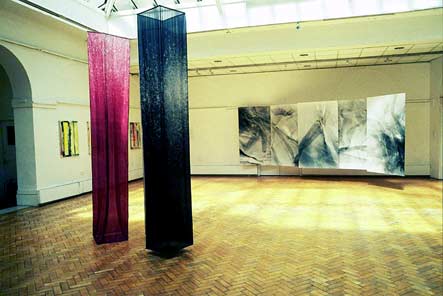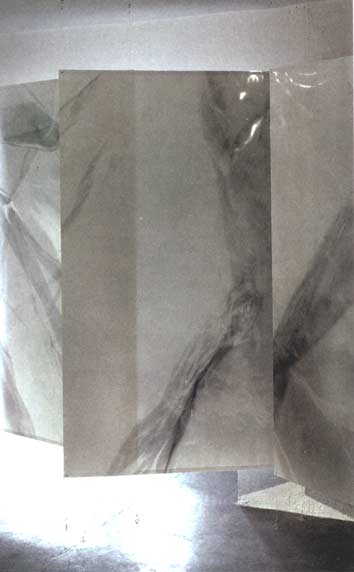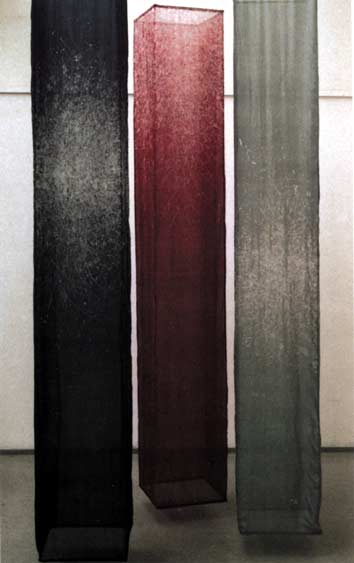Eight
Days A Week 2004 : Accidental lines & red splashes’,
Kòln Artists,
Liverpool School of Art, Hope Street Gallery,
68 Hope Street, Liverpool
Private
View Thursday July 8, 2004. 5.00 - 7.OOpm
July 9
- 21, Mon - Friday 10.00 - 4.00
Curated by Neil Morris and Pete Clarke, Liverpool and Georg Gartz,
Cologne.
Based
on: Georges Didi-Huberman `phasmes', Cologne 2001
`Von zufalligen linien und rotlichen flecken', Accidental lines and
red splashes
English translation: Margaretha Schcoring.
The events of
this story occurred Long before our time. One day in the fourth century
BC the famous painter Apelles, unable to complete a painting of Aphrodite,
picks up a sponge soaked with a mixture of water, paint and binderand
in his frustration and angerthrows it atthe painting. The sponge explodes
leaving the image on the surface disfigured. White foam reminiscent
of Aphrodite's birth out of the sea covers the painting like a veil.
Gradually
the veil recedes and reveals a grid of accidental lines and red splashes.
The painted figure of Aphrodite, whom Apelles detested or more likely
loved too much, is barely visible any longer. The splash has concealed
her body and the outlines become blurred. Just a moment ago his work
was unfinished now the issue seems settled. The presence of Aphrodite
even though she is no Longer depicted as such is stronger than before.
The act of destruction becomes a creative process.
Apelles perplexed as if in a dream: being pulled between the extremes
of clinging to reality and daring to believe in the unimaginable;
gazes at the miracle he unintentionally created. No further touches
are required to complete what Apelles set out to achieve.
The painting evokes astonishment and admiration in all those who see
it. Soon it becomes well known under its still famous title Aphrodite
anadyomene, she who sprung from the foam of the sea emerges and submerges,
appears and disappears.
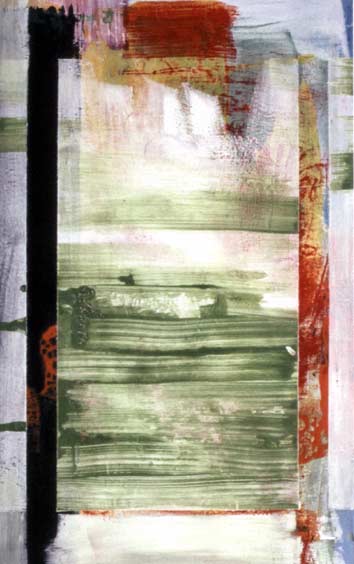 |
Georg Gartz Untitled Aicrylic on canvas 80cm.
2000
Georg Gartz : The colours in my paintings are layered like archaeological
remnants to convey a multitude of memories. Colours seemingly put
on canvas haphazardlyare immersed in rich manifold layers. Drips,
smears, blots or a pale veil; impenetrable yet transparent; then a
sudden burst of light: familiar and reassuring; a balance of opposites;
painting becomes a metaphor for life. In my paintings colours evolve
into shapes and forms without being a concrete representation allowing
the viewer to sense the tension created by harmony and discord. Born
in Krefeld 1955, Georg studied Fine Art at the Fachhochschule Koln.
He lives and works in Cologne and has exhibited in and outside of
Cologne, showcasing the diversity of his creative output. Co-founder
of the Eight Days a Week project Georg has collaborated with the Liverpool
based artist Pete Clarke since'99.
Michael
Wittassek: Untitled Installation
Photography is for Michael Wittassek the object and the medium of
his art. To start with he constructs his images using ordinary photographic
techniques. Then he subjects the prints to a process of manual alterations
using drawing and sculptural techniques. He rips, tears, scratches
and attacks the surface, before photographing the results of this
transitional process. The photograph appears to be a pretext to question
reality and its representation. The enlargements reinforce the optical
illusion of the tears like a trompe-l'oeul and incessantly agitate
the viewerto question.
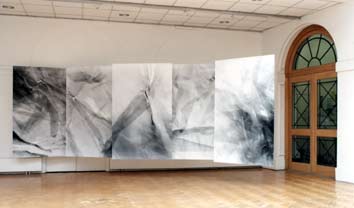 |
What does the
viewer look at and consider in such an image? The places and objects
of the initial photograph, the alterations of that representation
orthe alterations of the photographic surface or the skillful collage
of realities and mixed up representations-all of which are condensed
in one image on the smooth, flawless surface of the photograph.
Incidentally Wittassek questions the domain of sculpture, painting
and graphics through photography. The way in which these works are
installed adds to the turmoil. No definitive answers are given, instead
the viewer is prompted to reflect on reality, subjectivity and the
psychology of the image.
The main focal
point in the work of Veronika Moos is the use of textiles as a symbol.
Cloth is a soft and transparent material. Like skin: taking nearly
every shape and form, it adapts to all your movements and it has undergone
different metamorphoses. She experiments with different techniques
and explores various concepts as a form of awareness of one's surrounding.
Traditional expectations of textile material are contradicted and
so in this way, she creates new perspectives towards an ancient material.
Born near Cologne. Veronika studied Fine Art at Johannes Gutenberg
University Mainz. Germany She has exhibited extensively in Germany
and internationally.
Since 1999 she has participated in 'eight-days-a-week' and was the
organiser of 'made in Kiiln-gefunden in Liverpool'. the artist initiative
arranging an exchange between five Liverpool and five Cologne artists
as a part of the celebration of the 50th anniversary of the sister
cities Liverpool/Cologne in 2000.
currently Veronika is realizing the collaborate art project "belonging
& Beyond" with the Liverpool artist Lin hollard.
Tine Wille : "As
morning mowers. who side by side slowly and seethingly advance their
scythes through the long wet grass of marshy meads, even so these
monsters swam, making a strange, grassy. cutting sound; and leaving
behind them endless swaths of blue upon the yellow sea."
______________________________________________________________________________
Reviewed
by Tim Hughes : Liverpool School of Art & Design, Hope Street
July 9th - 21st
The Blurb as
I go in reads: "Liverpool School of Art and `Eight Days a Week'
presents `Von zufalligen linien und rottlichen flecken', and I have
to agree with them entirely.
It is part of a cultural exchange between Liverpool and Cologne, by
a group of German artists called Georg Gartz, Veronika Moos, Tine
Wille and Michael Wittasek.
I am not overly impressed with the modern-style paintings I first
come to; they remind me of when I helped my parents pull old wallpaper
from the wall when decorating; to reveal various bits of paper going
back through the generations! I'm sure they must mean something though.
However, any new style seeping into the consciousness of human beings
can take time.
Moving on, there are see-through pictures of what looks like wrapped
cellophane in all sorts of interesting patterns, and casting different
shadows. These are far more interesting to me, and certainly unusual
and different.
The rest of the pictures are curious scribbles, like the sort of things
kids paint in primary school. They are like dreams, or works of genius
that have lain, unfinished, and neglected, only to be gathered up
at some time and put on display. The exhibition on the whole has a
curious feel to it, I would say like many such exhibitions; inviting
but sterile, interesting but not engaging, curious but take-it-or-leave-it.
I must add that one of my colleagues was very impressed with the exhibition,
and rather than recanting what I have said, The artists who have displayed
their work here are obviously motivated in letting the world see their
work, and much of the work does have style and artistic merit, even
if I personally am not that taken with it.
The piece de resistance are three silken oblongs of material, in three
different colours, with scribble plant-like designs, hanging in the
middle of the room. I truly think its all a bit, well, not that interesting
to be honest, and I am not being intentionally cruel or funny, just
honest. Equally, this is my personal opinion and I wish not to hurt
anyone's feelings; we all must do what feels right, and hopefully
what moves us, and helps us move on to a better place. The only things
that really interest me are two glass tables by the door, full of
Liverpool and Cologne memorabilia, and blurbs advertising the exhibition.
Perhaps I am not in the best of moods, but I wonder when a group of
artists will create something that is as vital as it is interesting,
that has impact but also lasting appeal. I am not a snob, but I prefer
the old schools of painters and sculptors, when paintings where paintings,
and sculptures were sculptures, and you could buy a portion of chips,
well, for a halfpenny.
My last word is that all cultural exchange is a good thing, if we
can see how they live over there, and they can see how we live over
here.
. _______________________________________________________________________________________________

